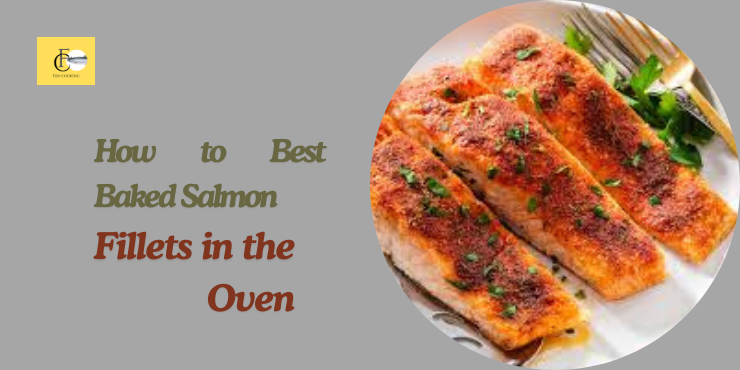Introduction
Baked Salmon Fillets in the Oven is one of the simplest and healthiest ways to enjoy this delicious fish. Not only is baked salmon easy to prepare, but it’s also packed with nutrients that are beneficial for your health. If you’re looking for a go-to recipe that’s both quick and satisfying, you’re in the right place. Let’s dive into the step-by-step process of baking the perfect salmon fillet in the oven.
Selecting the Perfect Salmon Fillet
The quality of your salmon fillet is crucial. When shopping, you’ll come across two main types: wild-caught and farm-raised. Wild-caught salmon tends to have a richer flavor and firmer texture, while farm-raised salmon is usually more budget-friendly and consistently available.
Wild-Caught vs. Farm-Raised
Wild-caught salmon is generally considered to be more sustainable and nutritious. It has a vibrant color and robust taste. On the other hand, farm-raised salmon can be more affordable and easier to find year-round, though it may have a slightly milder flavor.
Freshness Indicators
Always check for freshness when buying salmon. Fresh salmon should have a mild scent, not a strong fishy odor. The flesh should be firm and moist, not slimy, and the color should be bright and consistent.
Preparing the Salmon Fillet
Once you’ve selected your fillet, it’s time to prepare it for baking. Start by rinsing the fillet under cold water and patting it dry with paper towels. Check for any remaining bones and remove them with tweezers.
Cleaning and Deboning
Gently run your fingers along the flesh to locate any small pin bones. Use a pair of fish tweezers or clean needle-nose pliers to pull them out. This step ensures a more pleasant eating experience.
Removing the Skin (Optional)
Whether to remove the skin is a matter of personal preference. The skin can help retain moisture during baking, but some people prefer their salmon without it. To remove the skin, place the fillet skin-side down and slide a sharp knife between the flesh and the skin, holding the skin taut as you go.
Marinating the Salmon
Marinating your salmon can enhance its flavor and make it even more delicious. You can keep it simple with just salt, pepper, and a bit of olive oil, or you can get creative with more elaborate marinades.
Simple Seasoning vs. Elaborate Marinades
For a basic approach, sprinkle the fillet with salt, pepper, and a drizzle of olive oil. For something more complex, consider a marinade with soy sauce, honey, garlic, and ginger. Let the salmon marinate for at least 30 minutes to allow the flavors to penetrate.
Suggested Herbs and Spices
Some great herbs and spices for salmon include dill, thyme, rosemary, and parsley. You can also add lemon zest, garlic powder, or a touch of smoked paprika for extra flavor.
Preheating the Oven
Preheating your oven is an essential step for ensuring that your salmon cooks evenly. Set your oven to 375°F (190°C) and let it fully preheat before placing the salmon inside.
Ideal Temperature for Baking Salmon
Baking at 375°F is ideal because it allows the salmon to cook through without drying out. This temperature strikes a good balance, giving you a tender, juicy fillet with a perfectly flaky texture.
Importance of Oven Preheating
Preheating ensures that your oven reaches the correct temperature before you start baking. This step is crucial for achieving consistent cooking results.
Using a Baking Dish or Sheet
Choosing the right equipment can make a difference in your baking experience. Both baking dishes and sheets work well, but there are some considerations to keep in mind.
Choosing the Right Baking Equipment
A glass or ceramic baking dish helps retain heat and can give your salmon a slightly more tender texture. A metal baking sheet can result in a crisper exterior. Either option works, so choose based on your texture preference.
Lining the Baking Dish for Easy Cleanup
Lining your baking dish or sheet with parchment paper or aluminum foil can make cleanup much easier. It also prevents the salmon from sticking to the dish.
Placing the Salmon in the Oven
When placing the salmon in the oven, position it on the middle rack for the most even heat distribution. This helps the fish cook uniformly.
Positioning in the Oven for Even Cooking
Placing the salmon on the middle rack allows for even airflow and heat distribution around the fillet. This positioning helps prevent overcooking or undercooking certain parts of the fish.
Adding Vegetables or Other Accompaniments
Consider adding some vegetables to the baking dish for a complete meal. Asparagus, cherry tomatoes, and bell peppers are great options that bake well alongside salmon.
Baking Time and Temperature
The thickness of your salmon fillet will determine the exact baking time. A general rule of thumb is to bake salmon for about 12-15 minutes per inch of thickness.
Optimal Baking Duration
For most fillets, 15-20 minutes at 375°F will be sufficient. Check the salmon at the 15-minute mark to see if it flakes easily with a fork.
Adjusting Time for Different Thicknesses
Thicker fillets may need a few extra minutes, while thinner ones might be done a bit sooner. Always keep an eye on your fish to avoid overcooking.
Checking for Doneness
Determining when your salmon is perfectly cooked can be a bit tricky, but there are a few key indicators to look for.
Visual Cues of Perfectly Baked Salmon
Perfectly baked salmon will be opaque and easily flake with a fork. The flesh should still be moist and not dry.
Using a Meat Thermometer
For the most accurate results, use a meat thermometer. The internal temperature of fully cooked salmon should be 145°F (63°C).
Finishing Touches
Once your salmon is out of the oven, consider adding a few finishing touches to enhance its flavor and presentation.
Adding a Squeeze of Lemon
A squeeze of fresh lemon juice adds brightness and complements the rich flavor of the salmon. It’s a simple yet effective way to elevate your dish.
Garnishing with Fresh Herbs
Sprinkle some fresh herbs like dill, parsley, or chives over the top for a burst of color and flavor.
Serving Suggestions
Now that your salmon is perfectly baked, it’s time to think about what to serve it with. Here are a few ideas to get you started.
Ideal Side Dishes
Some great side dishes for baked salmon include roasted vegetables, quinoa, or a light salad. These options are healthy and pair well with the flavors of the fish.
Presentation Tips
Arrange your salmon on a platter with the sides around it for a visually appealing presentation. Adding a few lemon slices and herb sprigs can also enhance the look of your dish.
Health Benefits of Baked Salmon
Baked salmon isn’t just delicious; it’s also incredibly good for you. Here’s a look at some of its health benefits.
Nutritional Value
Salmon is high in protein and low in saturated fats, making it an excellent choice for a healthy diet. It also provides essential vitamins and minerals.
Benefits of Omega-3 Fatty Acids
Salmon is one of the best sources of omega-3 fatty acids, which are known to support heart health, reduce inflammation, and promote brain function.
Common Mistakes to Avoid
Even with a simple dish like baked salmon, there are a few common pitfalls to watch out for.
Overcooking
Overcooking is the most common mistake and can result in dry, tough salmon. Keep an eye on the cooking time and check for doneness early.
Using Too Much Seasoning
While seasoning is important, too much can overpower the delicate flavor of the salmon. Use herbs and spices sparingly to enhance rather than mask the fish’s natural taste.
Storing and Reheating Leftovers
If you have leftovers, proper storage and reheating are key to maintaining the quality of your salmon.
Proper Storage Methods
Store leftover salmon in an airtight container in the refrigerator. It will stay fresh for up to three days.
Reheating Tips to Maintain Flavor
When reheating, do so gently to avoid drying out the fish. The microwave works, but reheating in a low oven or on the stovetop is even better for preserving moisture.
Conclusion
Baking salmon fillets in the oven is a straightforward and rewarding process. With the right techniques, you can enjoy a delicious and nutritious meal that’s easy to prepare and sure to impress. So next time you’re looking for a healthy and tasty dinner option, give baked salmon a try. Happy cooking!
FAQs
How long does it take to bake salmon fillets at 400°F?
Typically, salmon fillets will take about 10-12 minutes to bake at 400°F. Always check for doneness to ensure the fish is cooked through but not overdone.
Can I bake frozen salmon fillets?
Yes, you can bake frozen salmon fillets, but they will need additional time. Expect to bake for about 25-30 minutes at 375°F, and check for doneness.
What are some good marinades for salmon?
Some popular marinades include soy sauce and honey, lemon and dill, and garlic butter. Each brings a unique flavor profile that complements the salmon well.
How can I tell if my salmon is fresh?
Fresh salmon will have a mild scent, firm flesh, and vibrant color. Avoid any fillets with a strong fishy odor or dull, slimy appearance.
What are some healthy sides to serve with baked salmon?
Healthy sides include roasted vegetables, quinoa, brown rice, and a fresh garden salad. These options are nutritious and pair well with the flavors of baked salmon.

